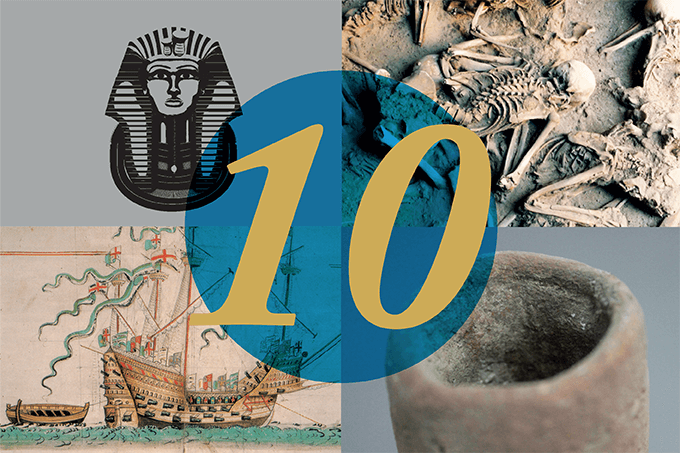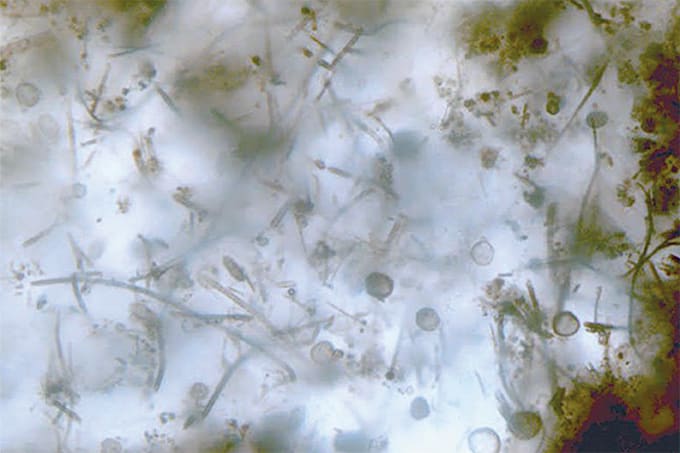The Mystery of the Sicán Mask
Analysis of the red paint preserved on the surface of a 1000-year-old gold mask excavated from a Middle Sicán tomb in Peru finds human blood and egg proteins – but why?
“When you ask questions about the past you have to be open to many possibilities. We can’t rule something out just because our current interpretation of the past is a certain way. More so than many other fields of study there is often only a very limited amount of material available so we must be careful about making general interpretations.”
Spectroscopy Strikes Gold
Spectroscopic techniques have authenticated Roman coins – validating the existence of a “new” emperor, called Sponsian.
“Emperor Sponsian has been written out of history because his existence is solely based on these coins – thought to be fake. But our analysis indicates this person probably really did exist. Sponsian ruled Roman Dacia, an isolated gold mining outpost, in 260 CE, at a time when the empire was beset by civil wars and the borderlands were overrun by plundering invaders.”
More Secrets of the Mary Rose
Henry VIII’s prized flagship had a multi-ethnic crew, according to multi-isotope analysis of teeth.
“Our findings point to the important contributions that individuals of diverse backgrounds and origins made to the English navy during this period. This adds to the ever-growing body of evidence for diversity in geographic origins, ancestry and lived experiences in Tudor England.”
Stories of the Dead
How analytical chemistry refines life after death.
“We next set out to conduct multi-element analysis of encrusted mineral residues on the bones by inductively coupled plasma-MS (ICP-MS). These residues ranged in color from light red to black, and impregnated the ash-filled intercranial cavities of the bodies and their ash-bed casings – but what are they? And what could they tell us about a disaster that happened almost two millennia ago?”
Who’s Our Daddy?
Paleoproteomics reveals the oldest human genetic evidence for our last common ancestor.
“Our findings indicate that H. antecessor is closely related to the last common ancestor of Homo sapiens, Neanderthals, and Denisovans. In the future, we want to analyze other hominin and animal fossils, to further our understanding of human evolution and the environments in which early hominins evolved.”
Meet the Met
We step behind the scenes at The Metropolitan Museum of Art, New York, to meet three scientists who are studying the art of the past – and driving art analysis into the future.
“Working with extremely small, very materially complex samples, we often only have one chance to obtain an answer. Sampling artworks is not something that is done without careful consideration with conservators and curators but it is necessary when we can’t answer the question with a non-destructive technique. Furthermore, the materials in artworks age over time, and the molecules interact with the atmosphere, light, and many different inorganic and organic materials. It is critical that our analytical methods are robust, reliable, and reproducible.”
The Tooth Will Out
LC-MS reveals the smokers of ancient societies – and it may not be who we thought.
“When anthropologists interviewed Native Californians in the late 19th and early 20th centuries, they recorded that it was mostly or exclusively men, especially those who practiced healing or doctoring, who used tobacco. Judging by our findings, there must have been women healers and doctors as well – they just weren’t recorded by the mostly male anthropologists who happened to mostly interview men.”
On the Dating Scene
Kirsty Penkman combines analytical science, archaeology, earth science, and oceanography to delve into the history of our planet.
“With geological and archaeological samples, we’re working at trace concentrations in incredibly complex samples that have undergone fascinating breakdown reactions. It’s a big analytical challenge – and I think that’s why many of us are drawn to this type of application. Of course, Earth scientists are now becoming increasingly trained in the use of routine geochemical and archaeological science methods, so it’s not always necessary to have chemists performing these analyses. However I think there’s always a role for analytical chemists to take the science further, to develop better methods and improve technology, which can later be used by a whole suite of different scientists.”
Good Things Come to Those Who Wait?
Ion chromatography helps students brew 5,000-year-old beer.
“The practice of beer brewing is likely to have been associated with the increased social complexity in the Central Plain during the fourth millennium BC. It indicates a mix of Chinese and Western traditions – barley from the West, millet, Job’s tears (a type of grass), tubers from China.”
King Tut’s Space Blade
X-ray fluorescence spectrometry uncovers the meteoritic origin of a dagger in Tutankhamun’s tomb.
“This confirms that before the advent of The Iron Age, ancient Egyptians considered the rare pieces of meteoric metal a valuable source for the production of precious ornamental objects. The high manufacturing quality of the dagger suggests that ancient people of the eastern Mediterranean area had acquired significant mastery in iron smithing already close to the end of the Bronze Age.”





